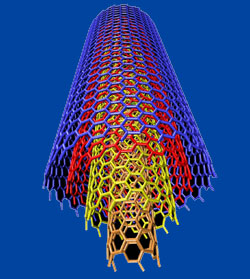A strip of paper, in which carbon nanotubes are embedded, is able to quickly and cheaply detect toxins emitted by algae in drinking water

Engineers from the University of Michigan have led the development of a state-of-the-art biosensor. The paper strips are able to detect a toxic chemical compound (Microcystin-LR) produced by cyano-bacteria, or blue-green algae, about thirty times faster than the most advanced methods available on the market today. This bacterium is common in water rich in nutrients.
Scientists estimate that the substance microcystin-LR (Wikipedia entry), even in tiny amounts, may cause damage to the liver and even cancer in this organ. This substance, and similar ones, are some of the main causes of biological pollution in water reservoirs. It is believed to be responsible for the mass poisonings that occurred at the dawn of human history, says Nicholas Kotov, a professor in the departments of chemical engineering, biomedical engineering and materials science who led the study.
Installations for removing impurities in water - even in developed countries - cannot always fully remove this substance, or even detect it, the researcher explains. The bio-sensor he and his colleagues developed provides a quick, cheap, portable and sensitive test capable of allowing the facilities that handle water contamination and the citizens themselves to assess the safety and quality of the drinking water on a regular basis.
"The safety of drinking water is a significant issue in many developing countries and in many regions of the USA," explains the researcher. "We have developed a simple and cheap method for detecting multiple toxins." The method can be easily adapted to the detection of a variety of harmful and dangerous substances or toxins in water and food. The research findings were published in the scientific journal Nano Letters.
The sensors work by measuring the electrical conductivity of the nanotubes in the paper. Before the nanotubes are embedded in the paper they are mixed with antibodies of the toxic substance. When the strips of paper come in contact with water contaminated with the toxin, the antibodies are pushed between the nanotubes to bind with the toxins. This expansion of the nanotubes changes the electrical conductivity, a change that can be measured and quantified. An external monitoring device measures the electrical conductivity. The entire device is the size of a home pregnancy test kit, and the results are obtained in about ten minutes, the researcher notes.
To adapt the biosensor to detect other toxins, all the scientists would need to do is simply change the antibodies attached to the nanotubes.

2 תגובות
Hello my people.
The said translation is taken from an official announcement of the university.
The term "seaweed" is the appropriate and accepted translation of the foreign term "algae"
appearing in the news, while the term "germ" is the appropriate translation for the term "bacterium".
There is no intention here to mislead or mislead the readers of my personal opinions...
Regards.
I recommend to stop using the incorrect and ancient title of algae for bacteria. Some 40 years have passed since the mistake was discovered, there is no point in continuing to document it. It is explicitly written in this article that it is a bacterium, so what is the advantage of using the name algae? If we want to describe the Earth, do we say "our round Earth or our flat Earth, the one that revolves around the Sun or the Sun around it…." No! It's over and done with. The sphere is round and we are around the sun. We also stated that the bacterium is a bacterium and not an alga.